Right ascension 20 45 38.0 Apparent dimensions (V) 3 degrees (diameter) Distance to Earth 1,470 light years | Declination +30° 42′ 30″ Radius 50 ly Magnitude 7 Apparent magnitude (V) 7 | |
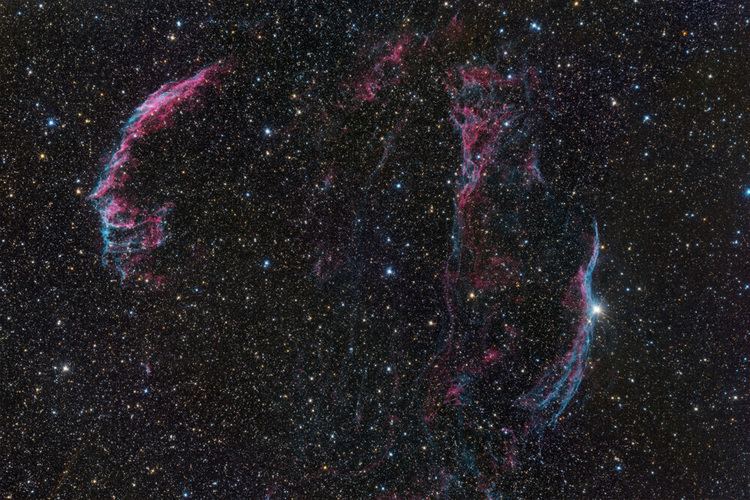 | ||
Designations NGC 6960, 6992, 6995, 6974, and 6979, IC 1340, Cygnus Loop, Cirrus Nebula, Filamentary Nebula, Witch's Broom Nebula (NGC 6960), Caldwell 33/34 Coordinates RA 20h 45m 38s | Dec +30° 42′ 30″ Similar North America Nebula, Crescent Nebula, NGC 7635, Rosette Nebula, Pelican Nebula | ||
Hubblecast 07 uncovering the veil nebula
The Veil Nebula is a cloud of heated and ionized gas and dust in the constellation Cygnus. It constitutes the visible portions of the Cygnus Loop (radio source W78, or Sharpless 103), a large but relatively faint supernova remnant. The source supernova exploded circa 3,000 BC to 6,000 BC, and the remnants have since expanded to cover an area roughly 3 degrees in diameter (about 6 times the diameter, or 36 times the area, of the full moon). The distance to the nebula is not precisely known, but Far Ultraviolet Spectroscopic Explorer (FUSE) data supports a distance of about 1,470 light-years.
Contents
- Hubblecast 07 uncovering the veil nebula
- Zooming in on the veil nebula
- Components
- Observation
- In fiction
- References
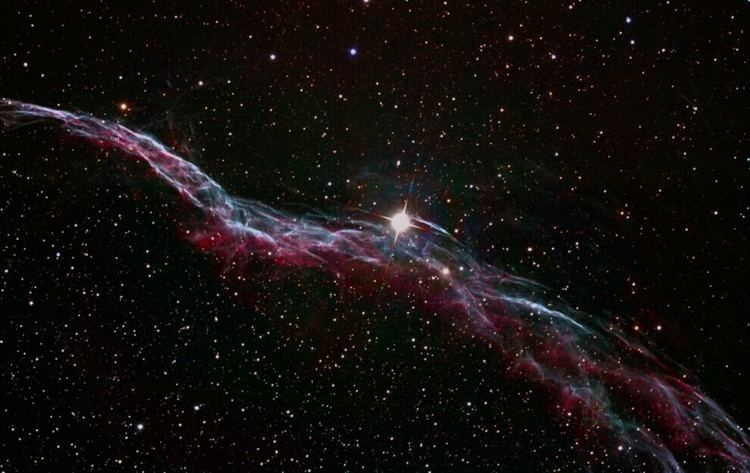
The Hubble Space Telescope captured several images of the nebula. The analysis of the emissions from the nebula indicate the presence of oxygen, sulfur, and hydrogen. This is also one of the largest, brightest features in the x-ray sky.

On September 24, 2015 new images and videos of the Veil Nebula were released, with an explanation of the images.
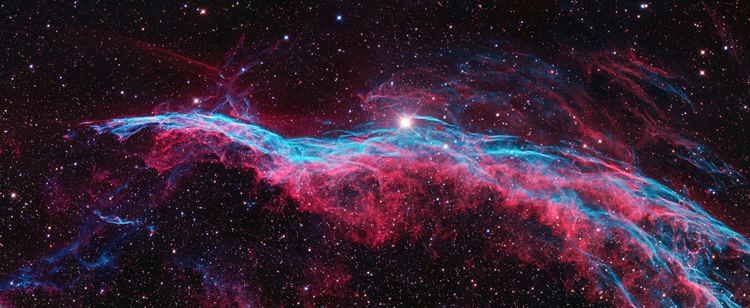
Zooming in on the veil nebula
Components
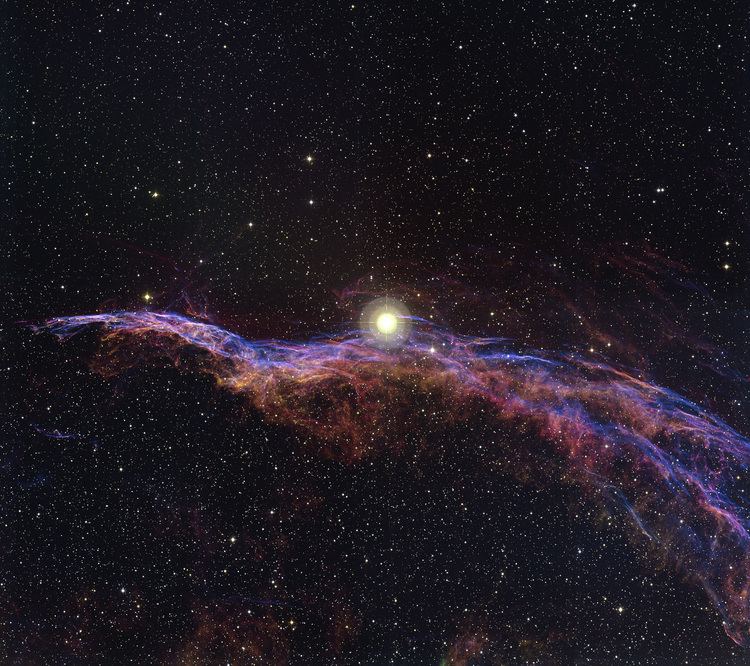
In modern usage, the names Veil Nebula, Cirrus Nebula, and Filamentary Nebula generally refer to all the visible structure of the remnant, or even to the entire loop itself. The structure is so large that several NGC numbers were assigned to various arcs of the nebula. There are three main visual components:
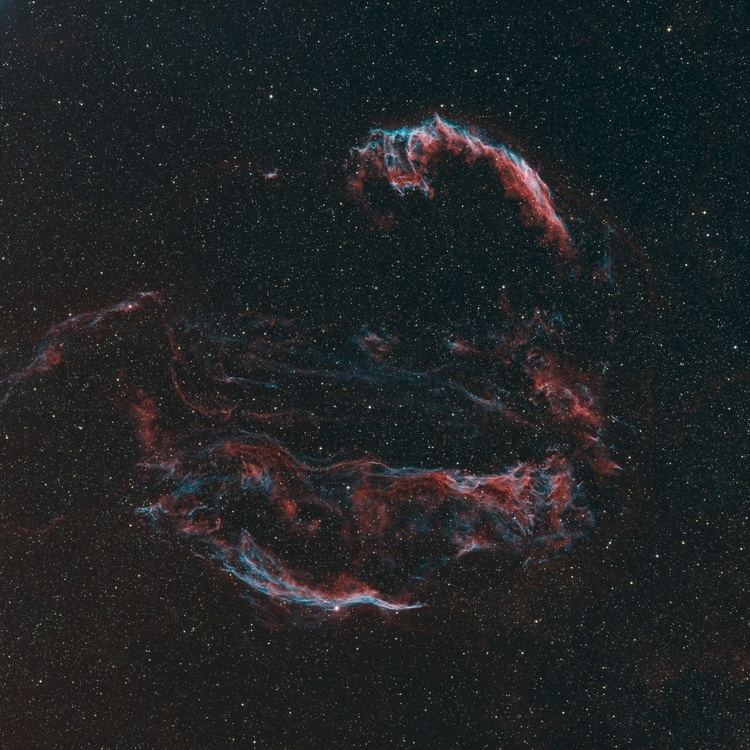

NGC 6974 and NGC 6979 are luminous knots in a fainter patch of nebulosity on the northern rim between NGC 6992 and Pickering's Triangle.
Observation
The nebula was discovered on 1784 September 5 by William Herschel. He described the western end of the nebula as "Extended; passes thro' 52 Cygni... near 2 degree in length", and described the eastern end as "Branching nebulosity... The following part divides into several streams uniting again towards the south."
When finely resolved, some parts of the image appear to be rope-like filaments. The standard explanation is that the shock waves are so thin, less than one part in 50,000 of the radius, that the shell is visible only when viewed exactly edge-on, giving the shell the appearance of a filament. Undulations in the surface of the shell lead to multiple filamentary images, which appear to be intertwined.
Even though the nebula has a relatively bright integrated magnitude of 7, it is spread over so large an area that the surface brightness is quite low, so the nebula is notorious among astronomers as being difficult to see. However, an observer can see the nebula clearly in a telescope using an OIII filter (a filter isolating the wavelength of light from doubly ionized oxygen), as almost all light from this nebula is emitted at this wavelength. An 8-inch (200 mm) telescope equipped with an OIII filter shows the delicate lacework apparent in photographs, and with an OIII filter almost any telescope could conceivably see this nebula. Some argue that it can be seen without any optical aid except an OIII filter held up to the eye.
The brighter segments of the nebula have the New General Catalogue designations NGC 6960, 6974, 6979, 6992, and 6995. The easiest segment to find is 6960, which runs behind the naked eye star 52 Cygni. NGC 6992/5 are also relatively easy objects on the eastern side of the loop. NGC 6974 and NGC 6979 are visible as knots in an area of nebulosity along the northern rim. Pickering's Triangle is much fainter, and has no NGC number (though 6979 is occasionally used to refer to it). It was discovered photographically in 1904 by Williamina Fleming (after the New General Catalogue was published), but credit went to Edward Charles Pickering, the director of her observatory, as was the custom of the day.
